Solar System Fun
From our small world we have gazed upon the cosmic ocean for thousands of years. Ancient astronomers observed points of light that appeared to move among the stars. They called these objects planets, meaning wanderers. The words "solar system" refer to the Sun and all of the objects that travel around it. Our solar system is made up of a star – the Sun – eight planets, 162 moons, dwarf planets and a bunch of comets, asteroids and other space rocks.
Our solar system is part of a galaxy known as the Milky Way and the Sun is the center of the solar system. Astronomers believe the solar system formed 4.5 billion years ago. The Sun contains 99.8% of all of the mass in our solar system. This mass has a tremendous gravitational pull on planets, satellites, asteroids, comets, and meteoroids. The stargazers also observed comets with sparkling tails, and meteors or shooting stars apparently falling from the sky. Asteroids and comets orbit our Sun in a flattened circle called an ellipse.
Illustration of our Solar System
A planet is a large space body which reflects the light of a star around which it revolves. The eight planets that make up our solar system are Mercury, Venus, Earth, Mars, Jupiter, Saturn, Uranus, and Neptune. They are named after Roman deities - Jupiter, king of the gods; Mars, the god of war; Mercury, messenger of the gods; Venus, the goddess of love and beauty, and Saturn, father of Jupiter and god of agriculture.
Not all planets are the same. Some of them aren't even solid. The planets in our solar system are classified as inner planets and outer planets. The inner planets, the closest to the Sun, are solid spheres of rock like Earth, they include Mercury, Venus, Earth, and Mars. For their first 600 million years, these inner planets were constantly bombarded by asteroids and meteorites. That is why you will find craters of varying sizes on the inner planets and their satellites. Think of the craters on the Moon and Mars. Man stepped onto the Moon in 1969 to study the rocks and craters. In this new century, NASA's Mars Exploration Rovers are learning about a place much further away, they are sending us back information about the craters on Mars. The Cassini spacecraft is providing a new look at spectacular craters recently found around the moons of Saturn. There are even craters on the Earth. Over millions of years, the wind, rain, ice, and water have all changed the surface of our Earth since the craters were formed. Still, we can find craters on our planet, like Meteor Crater in Arizona.
The outer planets are large gaseous planets with rings and include Jupiter, Saturn, Uranus, and Neptune. Saturn is not the only planet with rings. Jupiter, Uranus and Neptune have
rings, but they are very dark and millions of times less massive
than the rings of Saturn. Jupiter's rings are made of bits of
dust that fly off Jupiter's moons when they are struck by meteorites.
No one is sure what made the black rings of Neptune and Uranus.
Between the inner and outer planets is an asteroid belt. Some of the planets have naturally occurring satellites, or moons, while others do not. NASA is still making discoveries about the planets in our solar system and those beyond. What do you think will be discovered next?
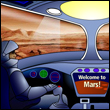 |
Mars Exploration Fun Zone Build a world on Mars, drive a rover, and have more fun at the Mars Fun Zone. |
| StarChild Just for you young astronomers. |
|
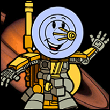 |
Cassini's Kid Space Discover the solar system with amazing stories, acitivities and art. |
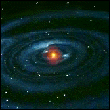 |
Movie of the Solar System Animation of swirling cloud in space. Sun being born. Planets being born. Cratered surface of rocky planet. Zoom out from central solar system to see the outer gaseous planets in their orbits. [+ AVI, 3.2MB | Quicktime, 3.2MB] |
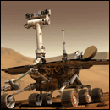 |
Rock Around the World Mars Scientists are asking students from around the world to help them understand the red planet. Send in a rock collected by you or your classroom from your region of the world and we will use a special tool like the one on the Mars Exploration Rovers to tell you what it's made of. |
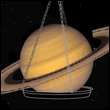 |
Compare the mass of planets The objects in our solar system have an enormous range of sizes and masses. This animation is intended to help you compare the masses of individual bodies of the planets, our Moon, and the Sun. |
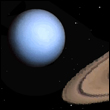 |
Compare the sizes of planets Mercury is the smallest planet. In fact, Mercury is not much larger than our Moon. In this animation you can find out how Mercury "sizes up" to Earth or any other planet. |
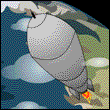 |
Go to Mars Plan your own trip to Mars. You and your crew are about to blast off to Mars! Now you must decide what to take on the long journey in space. |
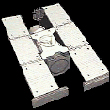 |
Paper models of your favorite spacecraft Have fun assembling these paper models of spacecraft designed to explore the solar system. |
